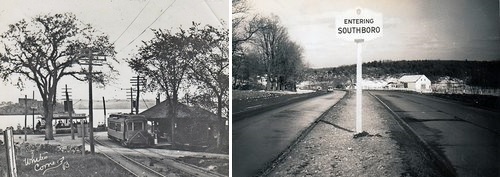Above: The Southborough Historical Society has been digging into our town’s history, including a look at the changes in transportation via train and the building of Turnpike Road (images from website)
Southborough Historical Society members have been working on updating their website recently. (It’s just one of the group’s efforts. I hope to post more about their work – and how you can support it – soon.)
One of their most recent posts offers a great look in the impact of transportation needs on the town’s landscape.
A Short History of Route 9, The Road You Love to Hate
For those of you stuck almost almost daily in gridlocked traffic on Route 9, staring at nothing but ugly concrete Jersey barriers and electronic billboards advertising products you don’t need, we thought you might like to read about life in another time, and how the road you love to hate came into existence in the first place.
The post features excerpts from “a charming account read before the Brookline Historical Society December 26, 1906, by Edward W. Baker”. It includes original language from 1806 for construction of Turnpike Road laid out a route from Roxbury to Worcester. Our stretch was designated:
near the house of Jonathan Rugg in Framingham; thence near the house of Deacon Chamberlain in Southborough; thence near Furbush’s Tavern in Westborough
Four toll gates were authorized along the route in unspecified locations. The passages describe the road as temporarily failing as a main thoroughfare before the rise of automobiles:
Although of great benefit to the traveling public [for three decades], the Worcester turnpike did not prove a profitable enterprise to its proprietors, even with sub-divided tolls. It paid few dividends, never six per cent, and finally the whole capital involved was totally lost. [Another cause of financial failure was active toll-avoidance on the part of many who used the road without payment, simply detouring around toll gates. Eds.]
[After the 1850s} there was little if any through-travel, and except for short stretches through the populous sections of towns, it retained not a shadow of its former popularity. Moss-covered stone walls or dilapidated weather-beaten fences marked its bounds; with here and there a turnout to enable the thirsty horses or cattle to drink from some clear-watered brook which flowed lazily under the roadway. The quiet and peacefulness along the way was undisturbed except by the clatter of the bell on some cow’s neck as she fed along the faintly marked side-path on the way to and from the nearby pasture.
For over fifty years, the old turnpike dozed and nodded in this sleepy sort of a way, until in the first years of the twentieth century its slumbers were disturbed by the sudden shock of the electric current, which, revolutionizing nearly every form of industry, has affected the problem of transportation in particular. Again the engineers and contractors covered the ground, and when they had finished their work the old road was so altered in appearance that never again can it be recognized, even by itself.
For the full post, and other interesting historical notes on Southborough, click here.



Wow, what a fantastic post. I love to read the history. Thank you very much for sharing. This is terrific.